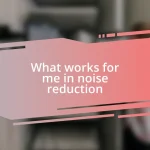Key takeaways:
- Portable recording setups enhance creativity by allowing high-quality audio capture in diverse environments, merging surroundings with sound.
- Choosing the right equipment, including microphones, interfaces, and headphones, is essential for capturing clear sound, with a focus on portability and quality.
- Small accessories like pop filters, tripods, and windscreens significantly improve recording quality, alongside proper mic placement and monitoring during sessions.

Understanding portable recording setups
When I first ventured into the world of portable recording setups, I was amazed at how convenient they could be. Imagine being able to capture high-quality audio in a coffee shop or even in a park on a sunny day; it really opened up a new realm of creativity for me. What if I told you that you don’t need a studio?
I remember my first recording project on the go—it was a bit nerve-wracking setting up my equipment in the hustle and bustle of a busy street. Yet, once I hit record and captured the ambient sounds, I was filled with excitement. It struck me how portable setups could fuse the environment into my recordings, allowing for a unique blend of location and sound. Isn’t it fascinating how our surroundings can become an integral part of our artistry?
Understanding the essential components of portable recording setups is crucial. They usually include a microphone, an interface or recorder, and often, headphones. I’ve learned that choosing lightweight and compact gear doesn’t mean sacrificing quality. Have you ever thought about the difference a good microphone can make? Even the tiniest details in sound can elevate your project from good to great!

Choosing the right equipment
Selecting the right equipment can truly transform your recording experience, allowing you to capture the sound as you envision it. After experimenting with various setups, I’ve found that each component should serve a purpose—adaptable, portable, and, most importantly, high-quality. I once lugged around a bulky recorder that sounded impressive but became a burden; I learned quickly that sometimes less is more.
Here are some key considerations when choosing your portable recording gear:
- Microphone: Opt for a condenser mic for studio-like sound quality, or a dynamic mic for versatility.
- Audio Interface: Look for a lightweight interface with USB output for easy connectivity to laptops.
- Headphones: Invest in closed-back headphones to monitor recordings without external noise interference.
- Cables: Ensure you have quality cables that are durable for outdoor environments.
- Storage: Carry a reliable external drive or cloud storage to manage your recordings efficiently.
By focusing on these elements, you’ll find that your recordings can reach new heights no matter where you set up.

Best microphones for portability
Choosing the right microphone is a game-changer in the world of portable recording. I remember once trying to record an interview in a park; the sound quality was crucial to capturing the moment authentically. I reached for my trusty shotgun mic, and the clarity was simply amazing, filtering out background noise while isolating the speaker perfectly. It highlighted how vital a good microphone is, especially in dynamic environments.
In my experience, the best portable microphones typically fall into a few categories: dynamic, condenser, and shotgun. Each offers its unique qualities, suited for different scenarios. For example, dynamic microphones are perfect for live settings, as they handle high sound pressure well. On the other hand, condenser mics excel in quiet environments, capturing subtle details that can elevate a recording. A shotgun mic is essential for focused recordings, especially when you want to hone in on a sound source, like capturing a soft voice in a bustling café.
Here’s a comparison of some of the top portable microphones that I’ve personally used or researched:
| Microphone | Type |
|---|---|
| Rode VideoMic Pro | Shotgun |
| Shure SM57 | Dynamic |
| Audio-Technica AT2020 | Condenser |
| Sennheiser MKE 400 | Shotgun |
| Rode NTG5 | Shotgun |
Selecting the right microphone often comes down to the specific recording situation, and finding the balance between portability and sound quality can be quite rewarding. Each choice in my setup reflects not just a technical decision, but also a unique storytelling opportunity—capturing the essence of my surroundings in every recording.

Essential accessories for mobile recording
When it comes to essential accessories for mobile recording, I’ve found that often, the small items can make the biggest difference. Take a quality pop filter, for instance; it’s a humble piece but invaluable. I remember a session where I forgot mine, and every “p” and “b” sounded like tiny explosions on the recording. It’s one of those moments where you realize that preventing undesirable sounds can elevate the overall quality of your work significantly.
Another key accessory is a portable stand or tripod. During a field recording of local musicians, I relied on a flexible mini tripod that allowed me to position my mic just right. It was liberating to not have to hold the mic, letting me focus on the music and the atmosphere instead. A sturdy yet lightweight stand gives you the freedom to experiment with angles and distances, bringing an added layer of professionalism to your recordings, even when you’re on the move.
Finally, don’t underestimate the power of a windscreen, especially if you plan to record outdoors. Once, while capturing soundscapes on a windy beach, I was initially frustrated as the gusts drowned out everything. Thankfully, I had a fluffy windscreen in my bag, and as soon as I attached it, the recordings transformed, preserving the beautiful sound of waves without the harsh interruptions from the wind. These little accessories may seem trivial, but they truly enhance your recording experience when you’re out in the field, where every detail counts.

Techniques for optimal sound quality
For optimal sound quality, positioning your microphones properly can truly make a world of difference. I recall a time when I was recording a live podcast in a crowded cafe. By experimenting with mic placement, I discovered that lowering the microphone just a few inches reduced background chatter significantly while capturing the speakers’ voices more prominently. It made me realize how critical an angle or distance can be—sometimes, the sweet spot is only a slight adjustment away.
Using high-quality cables is another technique I’ve learned can impact sound quality tremendously. Once, I used a generic cable for a recording session, and I was horrified to discover a persistent hum in my tracks. Since then, I stick to reputable brands for my cables; after all, they’re the lifeline of the audio signal. Investing in good cables pays off—clean sound starts from the ground up.
Lastly, I’ve found that monitoring sound during recording is crucial. I remember a session where I was so engrossed in the content that I neglected to listen through my headphones. When I reviewed the recording later, I realized that the levels were way too low. Using quality headphones not only helps you hear the nuances but also allows you to make adjustments on the fly. I often ask myself, what would I have missed if I had ignored this step? Trust me, your ears are your best friends in achieving outstanding sound quality.

Setting up your recording space
Setting up a recording space can be an exciting yet daunting task. I remember when I first transitioned from a makeshift setup to a more deliberate arrangement. Choosing a quiet corner in my home made a significant difference; I didn’t realize how much background noise from the city could seep in. It’s fascinating how acoustics can transform the quality of your work. Have you ever experienced that moment of clarity after eliminating distractions?
Lighting is another often overlooked aspect. I once recorded an interview late in the afternoon, and the soft golden light pouring in was so perfect that it transformed the entire atmosphere. I’ve learned to pay attention to how natural light changes throughout the day. Consider using adjustable lamps if you’re working indoors; they can create a cozy vibe while providing consistent lighting when the sun isn’t cooperating.
Lastly, I find that keeping my workspace organized sets the tone for creativity. When I have my equipment in designated spots, it sparks inspiration and makes the recording process smoother. Do you ever feel bogged down by clutter? I’ve realized that a tidy space not only enhances productivity but also calms my mind, allowing for more focused and vibrant recordings.















